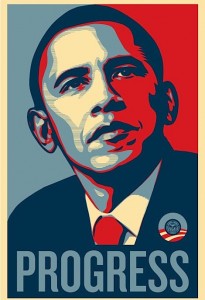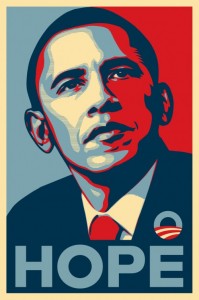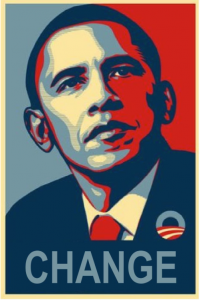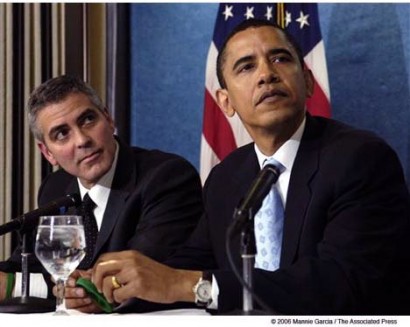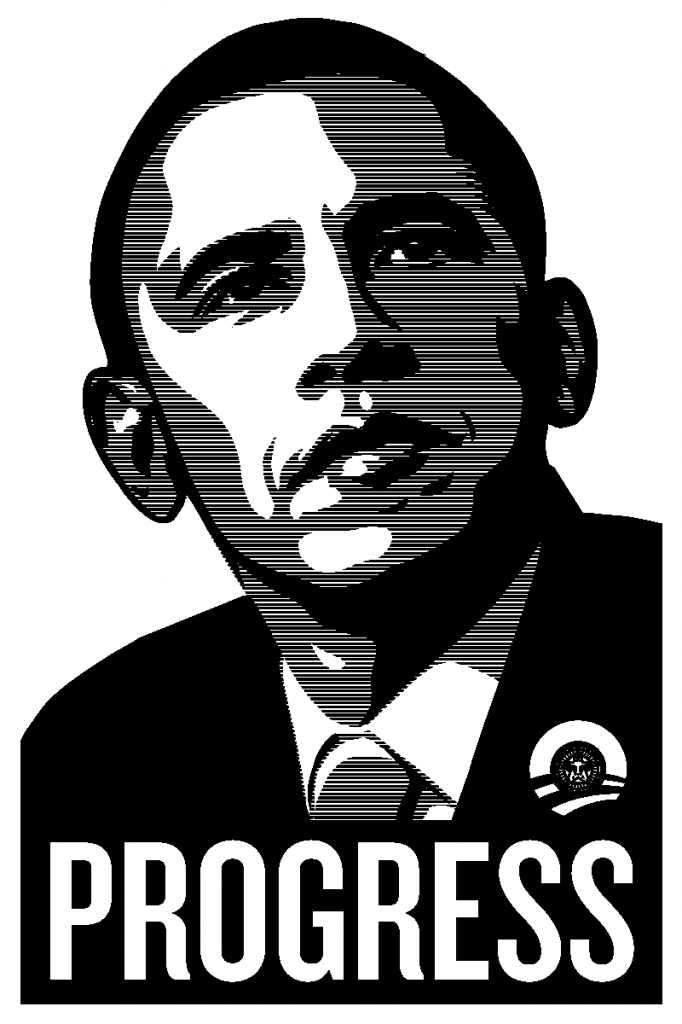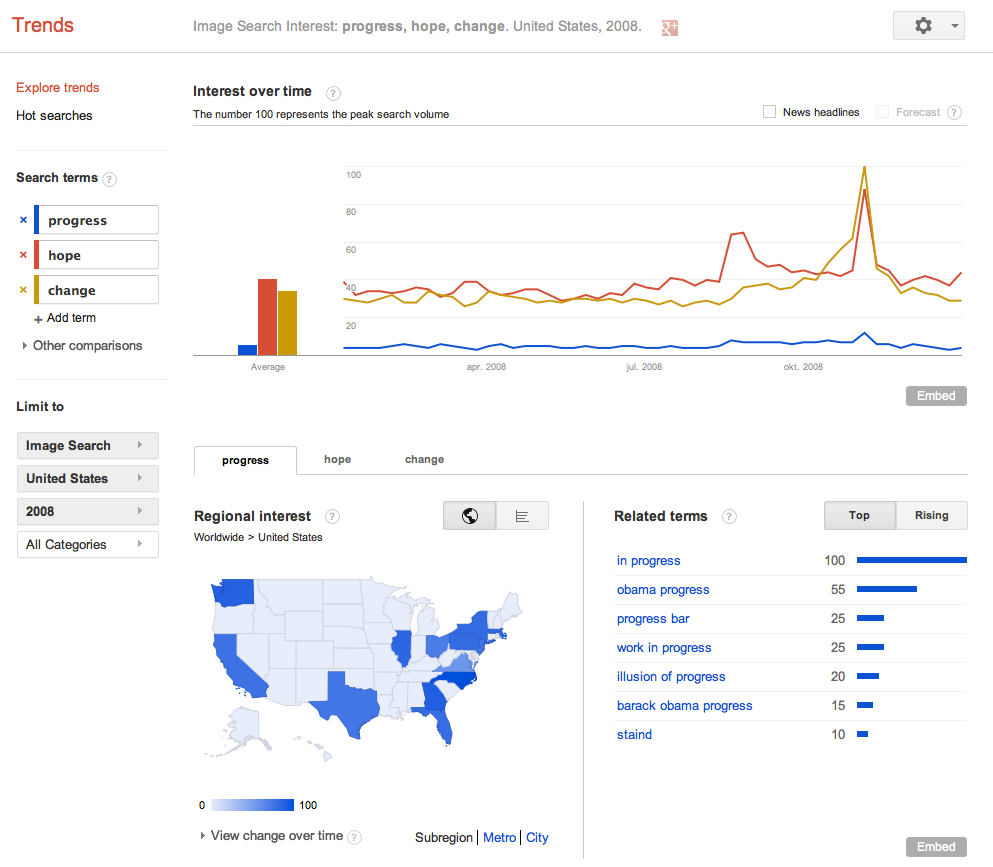Progress, hope, change and OBEY: Technological reproducibility in the digital age
PROGRESS, HOPE, CHANGE and Obama. These words got intertwined during the 2008 presidential campaign of Barrack Obama. The correlation factor: OBEY and the reproducibility of art in the age of digital reproduction.
The following is inspired by Walter Benjamin’s 1930’s essay The Work of Art in the Age of Its Technical Reproducibility. This will be an exploration on the use of technical reproducibility of art in the 2008 presidential campaign for Barack Obama. The specific cases are the Progress, the Hope and the Change posters (art pieces) created by OBEY. Likewise, it will be an exploration on how the technical reproduction (and distribution) of these works of art might have influenced the connotation of the words progress, change and hope, during the election period.
Walter Benjamin
In his essay, Walter Benjamin examines the way in which works of art can be used to interpret (changes in) the history of these artworks and humanity. He elaborates on the reproduction techniques in works of art and how these techniques affect the value and the use, from ritual to political, of these works of art. He also examines the way in which these technological reproduction devices (forms of technical media) have changed the human sensory apparatus, the way humans see and interpret the (natural) world. One particular aspect of this essay motivated the comparison with the posters/works of art for the presidential campaign. Benjamin argued that in absence of traditional or ritualistic value (mechanically) reproduced art would be based on the practice of politics. Taken (very) literally, this could be interpreted as the (potential) political use of mechanically reproducible artworks.
According to Benjamin, technical reproduction, like photography, separates the work of art with its ritual/cult. Though these works of art were (often) exhibited, cult value seemed to contain excessive exhibition. Through reproduction of the artwork, the purpose of the artwork shifted from purpose for ritual/cult to purpose for exhibition. As a consequence of this shift, especially visible within photography and film, the value of exhibition transcends the value of cult. A transition that exposes the possible political potential these reproductions (might) have. With this aspect of Benjamin’s essay in mind, I would like to introduce Shepard Fairey’s world of art.
Shepard Fairey / OBEY
Shepard Fairey is a Los Angeles-based street artist who goes by the artist name of OBEY. Shepard started doing street art in the late 80’s and specialized in stencil art. This form of art production involves the use of a paper, cardboard, or other material/media to create images and/or text that are easily reproducible with the use of (spray) paint. Another form of art which was practiced by Fairey, was sticker art. Most noticeable of these two forms of art, are their purpose for exhibition. Though it might be argued the artist is creates only one true piece of art, the stencil, the artwork in this form of art is found in the reproduction of the stencil. The sole concern of this art form, to put it bluntly, is exhibition.
In order to evince the (possible) political potential of art, the following will focus on one particular set of Fairey’s art works. In January 2008, inspired by Obama’s political vision, Fairey reworked a 2006 photo of Obama, shot by the former Associated Press freelance photographer Mannie Garcia.
By using and reworking the photographic image (an image itself derived from technical reproduction), Fairey created a mixed media digital stencil portrait of Barack Obama, containing the word progress. With the California democratic debate (set on January 31 2008) in mind, Fairey printed his digital image on 350 posters and started spreading the posters in Los Angeles, California on the 25th of January. Another way to spread the art, was by linking to a (digital) downloadable black and white version of the artwork (available on the 31st of January).
OBEY Barack Obama Progress Poster
In order to examine the effect on the image search with the word “progress” this might have had, an analysis of a search query can be of use. The following graph shows the percentage of search queries on Google Image Search containing the query progress, in California during the year 2008.
It is interesting to see that there was no progress of the query till the 27th of January. Since the 27th of January, the period in which Fairey started to distribute his art, the query progress showed a strong progression. In addition to Obama’s campaign, it must be mentioned that the theme progress was not (yet) used for the campaign program.
After the awareness Fairey created with his posters and digital images, he was approached by the Obama campaign team to rework his own artwork. The word progress had to be changed into hope and change, in order to fit the campaign program. The ‘new’ images/posters/products where used for the California primaries (presidential election) on the 5th of February, and the remainder of the national campaign.
When analyzing the Google Image Search queries “progress”, “hope” and “change” nation wide, two significant events show increasing progression: The Democratic National Convention on August the 28th and the Presidential Election (results) on the 4th of November.
An analysis of this type tends to ignore a lot of additional factors/influences on the relation of the words, the images, the works of art and the events. Therefore I am not saying Fairey’s works of art are the direct cause for the increasing popularity of certain words on Google Image Search. But, these results could indicate the political potential of technically and digitally reproduced works of art. Especially the connotative meaning of the words progress, hope and change in relation to images and (political) ideas. So a contemporary case of Benjamin’s argument might be found in the art and digital/technical reproduction of OBEY.
References
Google Trends. Google, 2012. <http://www.google.com/trends/>
Obeygiant. Shepard Fairey, 2012. <http://www.obeygiant.com>
Walter Benjamin, ‘The Work of Art in the Age of Its Technological Reproducibility (Second Version)’ [1935], in The Work of Art in the Age of Its Technological Reproducibility and Other Writings on Media, eds. Michael W. Jennings, Brigid Doherty and Thomas Y. Levin (Cambridge, MA: The Belknap Press, 2008), pp. 19-55.
